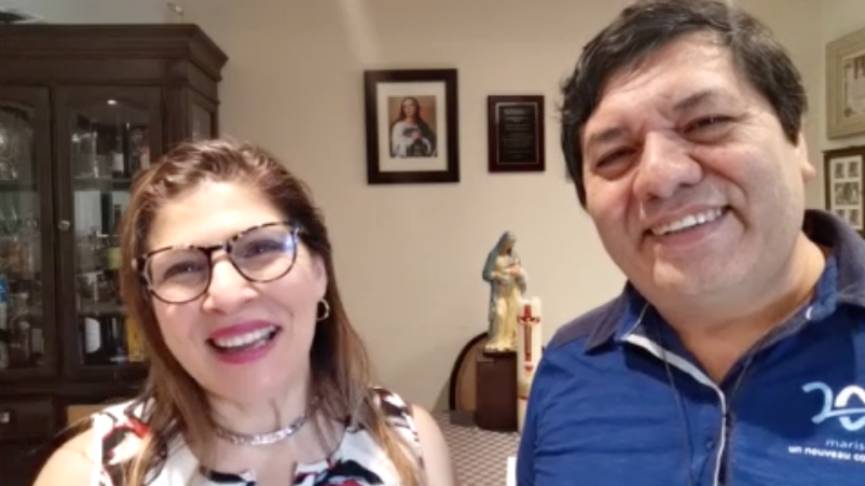Misión Santa Teresa de Ávila de Montréal: The Church Online

Montreal
The Misión Santa Teresa de Ávila had to close its doors when the measures related to the COVID were announced, but the mission was relatively ready to go online, and to use social media, to continue to stay in touch with the community despite the events.
Fernando Castro and Azucena Rios are involved, as a couple, in one of the Spanish-speaking parishes in Montreal: Misión Santa Teresa de Ávila. Fernando is a spiritual life leader in schools; he is also in charge of the youth ministry in the church. As for Azucena, immigration is her line of work. Together, they are in charge of catechesis and of all means of communication in the church. The diaconate is also their next step as a couple. Their smile and energy are contagious, and show how important being involved in their community is to them.
They have been concerned by the Web component for six or seven years now: “We started with a blog for the little ones by finding videos on the Internet.” After that first step, we started wondering: “Why not put catechesis online for everyone to enjoy?” And that question led to: “Why don’t we create a website for the Misión Santa Teresa de Ávila?” said Azucena. Catechesis in Spanish, a resource otherwise costly and hard to find in Montreal, was then made accessible to all.
Catechists started using screens the parish had been equipped with, projecting data from their smartphones during meetings with children and adults. Some months prior to the crisis, Fernando had started to learn online how to use Zoom to lead spiritual events. “When the COVID pandemic hit, we had already developed a certain expertise, and we told our parish priest—who supports us—that we could start using Facebook for mass right away.”
The Church “en Casa”
As Azucena says, “We immediately tried to connect with the community” at Misión Santa Teresa. “The Church, it’s in-house now,” also said Pope Francis. So we try to bring households together to pray. Every week we get new readers, play music and recruit new people. That’s the beauty of it. We include children and families in the prayer intentions process, and we adapt to the situation.”
Though the team quickly found alternatives, things needed to unfold one step at a time, the priority being the Mass, then the Holy Week, catechesis, etc. Finding ways to get everyone involved was the goal. “We first held masses on Facebook Live. Then we thought: Why not on Zoom? That way we’ll get people to participate in the readings, the offerings and in every aspect of the mass.”
A technical committee was set up to help people, especially the elderly, for whom technology is challenging. No one was left out. Everything is done in small groups, each being in charge of an individual item, such as the readings, slideshows, etc.
The parish also holds the rosary online, workshops to break single people’s isolation (drawing, painting, etc.), and streams an Internet radio. In short, there is a desire to be “highly present and alive”.
A Church all around the planet … online!
Being online allows this community to stay in touch with family or mission members who are stuck elsewhere on the planet: “We come originally from various Latin-American countries and from Spain. We now hold international meetings on Saturdays! The word has spread. Now about twenty people join us from Argentina,” says Fernando.
“After the [COVID] pandemic struck, people understood what we had been trying to do over the last three years: bringing our church online,” says Azucena. People were reluctant at first. Others had regrets afterward, because they had not familiarized themselves with online tools prior to the crisis, and were not able to respond to it. “People are now used to these tools,” says the couple, “to the benefit of everyone.” They add: “While teaching catechesis, we saw that to communicate with young people and their parents, there was a need to evangelize differently, through social media.”
“How can we communicate in a better way to reach more people?”
That is what led this couple to devote their time and energy exploring online resources, in order to adopt a language more adapted to this day and age. “We must create a Committee for technology and evangelism to link both notions,” we told our priest. “The community will benefit from it, and all groups must participate to generate something new, in order to step out of the physical structure,” says Azucena. She and her husband seem convinced that these are magnificent tools that are within reach to evangelize more widely.
Of course, the couple is eager to meet with real live individuals, and they certainly do not pretend having no need to be in people’s presence. “Emotionally, it’s something else. No one can take that away from us. That’s what we miss. Oh God, solitude is the most difficult aspect of confinement.” The desire to bring the church online is complementary to any parish life, and a way to reach out to the other, going forth.
To follow the news of the Misión Santa Teresa de Ávila, click here!
To discover catechesis online, click here!
To see all the events and masses online, click here!
To visit their website, please click here.

Comment
Comment
Add new comment